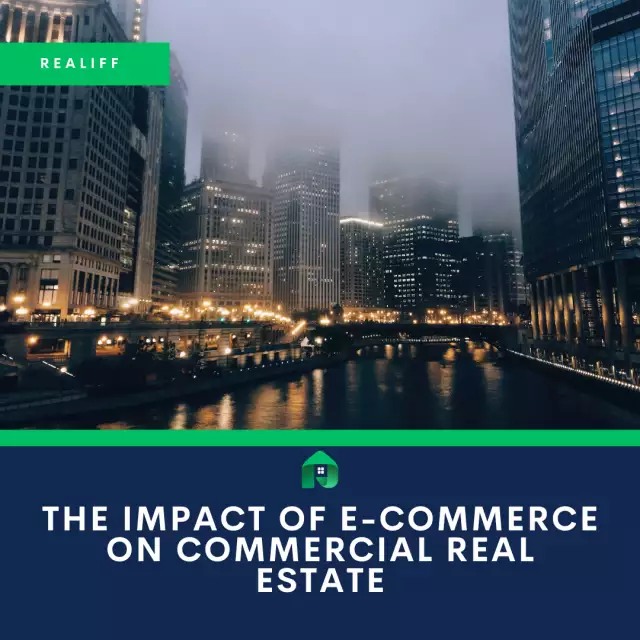The Impact of E-commerce on Commercial Real Estate
E-commercefacilitated through the Internet, has revolutionized consumer shopping habits, altering the retail landscape fundamentally. The ease of online transactions and vast product accessibility have redefined how consumers perceive and engage in commerce. As a result, traditional retail models have been profoundly impacted, causing a ripple effect throughout the commercial real estate sector, prompting the need for adaptation and innovation.
Historical Perspective
The historical perspective of e-commerce reveals a journey closely entwined with the evolution of the internet itself. Initially, in the early days of the World Wide Web during the 1990s, e-commerce was a novel concept, and its potential was only beginning to be realized. It was a time of experimentation and limited capabilities, marked by the pioneering efforts of a few early adopters. Internet users were cautiously exploring the idea of making transactions online, mostly limited to essential exchanges of information and occasional purchases.
However, as the internet infrastructure improved, along with online transactions' growing reliability and security, e-commerce gained substantial traction in the late 20th century. The late 1990s and early 2000s saw a surge in online marketplaces, with companies like Amazon and eBay paving the way for the e-commerce revolution. These platforms allowed consumers to browse a vast array of products and make purchases from the comfort of their homes.
Advancements in secure payment gateways and the introduction of innovative online marketing strategies further fueled the e-commerce boom. Consumers began to trust online transactions, and the convenience of shopping from home or on the go became increasingly appealing. Retailers also recognized the potential of e-commerce in reaching a global audience without the constraints of physical store locations.
This transformation led to a significant shift in consumer behavior, challenging the traditional brick-and-mortar retail model. Consumers were now presented with an alternative, where they could access a broader range of products, compare prices, and read reviews—all with a few clicks. This shift steadily eroded the dominance of brick-and-mortar retail, and e-commerce emerged as a formidable force reshaping the retail landscape.
As we move forward, e-commerce continues to evolve, incorporating new technologies like artificial intelligence, augmented reality, and virtual reality, promising even more personalized and immersive shopping experiences. The historical trajectory of e-commerce underscores its remarkable journey from humble beginnings to a dominant force, profoundly impacting how we engage with commerce and reshaping the world of retail.
Changing Retail Landscape
The advent of e-commerce has instigated a transformative shift in the retail landscape, profoundly impacting consumer shopping behaviors and preferences. The key catalysts for this transformation are the unprecedented levels of convenience, extensive product choices, and seamless transactions offered by e-commerce platforms. Consumers now have the ability to browse and purchase a wide array of products or services from the comfort of their homes, eliminating the need for physical visits to traditional retail outlets.
The convenience factor plays a pivotal role in this paradigm shift. E-commerce enables consumers to shop 24/7, breaking free from the constraints of traditional store hours. This accessibility aligns with modern lifestyles, where time is a valuable commodity. Furthermore, the ease of finding desired products through search algorithms and personalized recommendations significantly enhances the shopping experience.
The vast assortment of products available online is another compelling draw for consumers. E-commerce platforms offer a broad range of options across various categories, often exceeding what a brick-and-mortar store can accommodate. This diversity caters to diverse tastes and preferences, attracting a more extensive customer base.
Moreover, the seamless and secure transactions facilitated by e-commerce platforms provide a sense of trust and confidence among consumers. Advanced payment gateways and secure transaction systems have contributed to eliminating apprehensions regarding online financial transactions. This has bolstered consumer trust and further accelerated the transition towards online shopping.
However, this transformation has not come without consequences for traditional retail outlets. The surge in e-commerce has resulted in a noticeable decline in foot traffic and sales at brick-and-mortar stores. Consumers, drawn to the convenience and options offered by e-commerce, are less inclined to visit physical retail locations. As a result, traditional retailers are facing challenges in sustaining their sales and profitability, leading to a decreased demand for physical retail spaces.
In response to these shifts, many traditional retailers are now embracing omnichannel approaches, integrating online platforms with their existing physical stores to provide a seamless shopping experience across both mediums. The changing retail landscape thus necessitates adaptability and innovation within the retail sector, as well as a reevaluation of the role and utilization of physical retail spaces to remain relevant and competitive in this evolving retail era.
Shift in Tenant Requirements
The rapid growth of e-commerce has brought about a fundamental shift in the requirements of tenants within the commercial real estatesector. E-commerce businesses, distinct from traditional retailers, necessitate specific spatial configurations and strategic location considerations to effectively manage their online operations, facilitate seamless order fulfillment, and optimize last-mile delivery processes. This change in requirements has triggered a notable surge in demand for particular types of commercial real estate properties, reshaping the dynamics of the real estate market.
One of the primary demands of e-commerce businesses is strategically positioned distribution centers. These centers act as crucial hubs in the e-commerce supply chain, facilitating the storage and sorting of a vast array of products. Placed strategically, these distribution centers help in streamlining the order processing and shipping procedures, ultimately reducing delivery times for customers. As a result, there has been an escalated demand for large, strategically located warehousing spaces that can efficiently accommodate the inventory and logistical needs of e-commerce companies.
In addition to distribution centers, fulfillment centers have emerged as a critical requirement for e-commerce enterprises. These centers play a pivotal role in order assembly, packaging, and preparing shipments for last-mile delivery. Proximity to major transportation routes, urban centers, and densely populated areas is essential for fulfillment centers to ensure swift and efficient delivery operations. Consequently, the demand for appropriately located fulfillment centers has skyrocketed, leading to a surge in demand for commercial real estate properties that can cater to these specific needs.
Commercial Real Estate Agent Description !?
Furthermore, last-mile delivery, the final leg of the delivery process, has gained paramount importance. E-commerce companies are increasingly focused on optimizing this crucial step to enhance customer satisfaction. To achieve this, they require localized facilities strategically positioned near urban centers to ensure rapid and timely deliveries to consumers. This has created a notable uptick in demand for smaller, strategically located delivery hubs and urban warehousing spaces that can effectively support last-mile delivery operations.
Impact on Warehousing and Logistics
The exponential growth of e-commerce has brought about a seismic impact on warehousing and logistics, fundamentally altering the way goods are stored, processed, and delivered. This paradigm shift has triggered an unprecedented surge in demand for specialized warehousing and logistics facilities, which are now considered pivotal components of the e-commerce supply chain.
Distribution Centers:E-commerce's rapid rise has necessitated the establishment of strategically positioned distribution centers. These distribution hubs act as nerve centers for inventory storage and management, strategically placed to optimize the supply chain. They serve as consolidation points where products from various manufacturers are received, sorted, and then dispatched to fulfillment centers or directly to consumers. The strategic positioning of these distribution centers enables shorter shipping routes, ensuring rapid delivery times, a key competitive advantage in the e-commerce industry.
Fulfillment Centers:Fulfillment centers are a cornerstone of the e-commerce ecosystem. They are specialized facilities designed for order processing, packing, and dispatching products to customers. As e-commerce platforms often deal with a vast array of products, fulfillment centers are organized to accommodate diverse inventory and streamline order fulfillment efficiently. These centers utilize advanced automation and robotics to enhance operational efficiency, allowing for quicker order turnaround times and improved accuracy in order processing.
Last-Mile Delivery Optimization:The demand for last-mile delivery solutions has witnessed a sharp increase due to the burgeoning e-commerce activity. Last-mile delivery refers to the final leg of the delivery journey, from the distribution center or fulfillment center to the customer's doorstep. To meet the growing demand for faster and more reliable deliveries, companies are investing in advanced technologies and optimizing routes. This has led to innovations such as autonomous delivery vehicles, drones, and delivery lockers strategically located for convenient access.
Efficiency and Technology Integration:Warehousing and logistics have seen a significant integration of technology to enhance efficiency. Warehouse management systems (WMS) and transportation management systems (TMS) powered by advanced algorithms and AI are being employed to optimize inventory management, order processing, and route planning. Predictive analytics are used to forecast demand accurately, enabling better resource allocation and inventory stocking.
Environmental Considerations:The e-commerce boom has also brought increased awareness of sustainability in warehousing and logistics. Efforts are being made to reduce the environmental impact through energy-efficient warehouses, sustainable packaging materials, and optimizing transportation routes to minimize carbon emissions. This sustainable approach is becoming increasingly critical as environmental concerns gain prominence in global agendas.
Adaptive Reuse and Redevelopment
The decline in traditional retail, a consequence of the pervasive rise of e-commerce, has left a noticeable surplus of empty retail spaces in its wake. These once-thriving storefronts and shopping malls, grappling with reduced foot traffic and declining sales, now present a unique challenge and opportunity for property owners and developers. In response to this shifting landscape, they are embracing adaptability and innovation, recognizing that the key to rejuvenating these spaces lies in repurposing them to meet the demands of a rapidly evolving market. From these remnants of a bygone era, a new generation of commercial real estate is emerging. Former retail spaces are being reimagined and transformed into dynamic distribution hubs, strategically positioned to facilitate the efficient flow of goods in the e-commerce age. Moreover, these spaces are finding new life as coworking environments, catering to the burgeoning demand for flexible and collaborative workspaces in a post-pandemic world. They are also being revamped into fulfillment centers, central to meeting the surging demand for online orders. Furthermore, experiential stores, providing immersive and engaging retail experiences, are gaining traction, breathing fresh vitality into these once-static spaces. This adaptive repurposing not only breathes life into underutilized properties but also symbolizes a forward-thinking approach, acknowledging the imperatives of modern consumer preferences and technological advancements.
Technological Integration in Commercial Real Estate
In the rapidly evolving landscape of e-commerce, the commercial real estate industry is harnessing the potential of advanced technologies to stay ahead of the curve and meet the ever-changing needs of the digital era. Data analytics, a linchpin of this transformation, is being seamlessly integrated to optimize supply chains and revolutionize inventory management. By leveraging powerful analytics tools, real-time data insights enable stakeholders to make informed decisions, forecast demand accurately, and streamline the supply chain, ultimately enhancing operational efficiency.
Automation, another vital component of this technological shift, is being deployed to automate routine tasks and processes within the commercial real estate sphere. Automated systems are streamlining operations related to property management, lease administration, and facility maintenance. This not only expedites processes but also reduces human error, allowing for a more agile and precise response to market dynamics and tenant requirements.
Moreover, the integration of Internet of Things (IoT) devices is instrumental in enhancing operational capabilities and optimizing resource utilization. IoT-enabled sensors and devices are being deployed across various aspects of commercial real estate, from smart buildings to logistics centers. These devices provide real-time monitoring and data collection, allowing for predictive maintenance, energy efficiency, and the creation of intelligent, data-driven environments that adapt to the needs of tenants and businesses.
The synergy of these technologies is fostering a new era in commercial real estate where data-driven decision-making, operational streamlining, and resource optimization are at the forefront. The industry is rapidly embracing these technological advancements to not only meet the needs of e-commerce but also to remain competitive, agile, and future-ready in a digital-first world. As technology continues to evolve, the commercial real estate sector will undoubtedly continue to explore and integrate innovative solutions that drive efficiency, sustainability, and enhanced experiences for all stakeholders involved.
Urban vs. Suburban Trends
The influence of e-commerce on commercial real estate is distinctly marked by the divergent impact it has on urban and suburban areas. In urban landscapes, the e-commerce surge has triggered a surge in demand for last-mile delivery facilities. Last-mile delivery, the final leg of the product's journey from a distribution hub to the customer's doorstep, has become a critical focal point. E-commerce companies are strategically placing last-mile delivery facilities in urban centers to ensure swift and efficient deliveries to a densely populated customer base. This demand is fueled by the need for quick delivery turnaround times and the desire to enhance customer satisfaction, reflecting the changing dynamics of consumer expectations in the digital age.
Conversely, in suburban regions, the e-commerce boom has led to a growing preference for distribution centers. The availability of ample space in suburban areas, often at a lower cost compared to urban locales, is a major factor driving this trend. Distribution centers, critical components of the e-commerce supply chain, require extensive space to efficiently manage inventory and facilitate seamless order processing. Suburban locations provide the necessary room for large warehouses, making them attractive options for e-commerce companies. Additionally, the proximity of these suburban locations to major highways ensures streamlined logistics and swift connectivity to broader geographic regions, making them optimal choices for housing distribution hubs.
Sustainability and E-commerce
E-commerce companies are increasingly focusing on sustainability. This is influencing the design and construction of commercial real estate properties, with an emphasis on energy-efficient warehouses and eco-friendly delivery options to reduce the carbon footprint associated with e-commerce operations.
A Beginner's Guide to Investing in Commercial Real Estate
Challenges and Future Outlook
While e-commerce undeniably unlocks a realm of promising opportunities within the commercial real estate sector, it does not come without its share of challenges. These challenges necessitate a proactive and adaptive approach from industry stakeholders to thrive in the evolving landscape shaped by digital commerce. One significant challenge arises from the potential oversupply of certain retail spaces, especially those once dedicated to traditional brick-and-mortar retail. As the shift towards online shopping escalates, there's a risk of an oversaturated retail real estate market. Properties once bustling with shoppers might face vacancies, demanding innovative repurposing strategies to breathe new life into these spaces.
Moreover, consumer preferences in the e-commerce era are continuously evolving. The demand for seamless online experiences, faster delivery, sustainability, and personalized services is shaping how commercial spaces are envisioned and utilized. This evolving preference necessitates a recalibration of commercial real estate offerings to align with what modern consumers seek. Flexibility, sustainability, and technology integration will be the hallmarks of successful commercial spaces as they adapt to the demands of a tech-savvy and environmentally-conscious consumer base.
Amidst these challenges, the future of commercial real estate appears to be heading towards a transformative journey. It will see a shift towards multi-purpose and adaptive spaces, blending the physical and digital realms to create innovative solutions. The need for strategically positioned distribution centers and last-mile delivery facilities will continue to rise, dictating a shift in the geographical focus of real estate developments. Additionally, advancements in technology, like virtual reality and augmented reality, could reshape the way consumers interact with commercial spaces, allowing for immersive experiences and attracting foot traffic in novel ways.
Case Studies and Examples
Several case studies and examples highlight the successful adaptation of commercial real estate to the e-commerce boom. For instance, the repurposing of shopping malls into fulfillment centers showcases the industry's ability to innovate and evolve with changing times.
Introducing Realiff.com
Realiff.com, as an AI-based real estate platform, stands at the forefront of leveraging cutting-edge technology to revolutionize the way commercial real estate interacts with the burgeoning e-commerce landscape. This innovative platform integrates artificial intelligence to optimize the match between e-commerce requirements and commercial real estate offerings. By employing sophisticated algorithms, Realiff.com can precisely analyze the spatial and logistical needs of e-commerce businesses, effectively linking them with suitable commercial properties. This leads to an expedited and streamlined process of identifying appropriate warehouses, distribution centers, and fulfillment facilities, ensuring that e-commerce enterprises find spaces that align with their operational demands. Moreover, Realiff.com employs predictive analytics to forecast future trends, helping investors and developers make informed decisions regarding property investments in the rapidly evolving e-commerce ecosystem. By harnessing the power of AI, Realiff.com transforms the commercial real estate landscape, enhancing its adaptability and responsiveness to the dynamic shifts brought about by e-commerce, ultimately fostering growth and prosperity within the industry.
Conclusion
The growth of e-commerce has been a transformative force for the commercial real estate sector. It has redefined the way commercial spaces are utilized and created new opportunities for investors, developers, and property owners. Adapting to these changes and embracing technology will be crucial for the future success of the commercial real estate industry in the age of e-commerce. Investment strategies also, in commercial real estate are evolving due to the rise of e-commerce. Factors such as location, size, adaptability to e-commerce needs, and potential for repurposing are becoming increasingly significant in determining the value and attractiveness of commercial properties.



